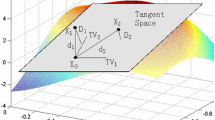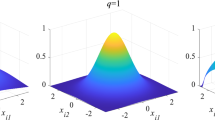Abstract
How to deal with the high-dimensional and nonlinear data is a challenging problem for fault diagnosis. An unsupervised locally tangent space alignment (LTSA) has recently proven to be an effective unsupervised manifold learning algorithm for high-dimensional data analysis. In this paper, a supervised expansion of LTSA (named S-LTSA) is proposed, which takes full advantage of class label information to improve classification performance. Based on S-LTSA, a novel machine fault diagnosis approach is proposed to deal with the high-dimensional fault data that contain multiple manifolds corresponding to fault classes. The experiment results with bearing fault data show that the proposed approach outperforms the other fault pattern recognition approaches such PCA, ICA, LDA and LTSA.
Similar content being viewed by others
References
H. S. Seung and D. L. Daniel, The manifold ways of perception, Science, 290 (2000) 2268–2269.
I. T. Jolliffe, Principal component analysis, Springer (2002).
Weixiang Sun, Jin Chen and Jiaqing Li, Decision tree and PCA-based fault diagnosis of rotating machinery, Mechanical Systems and Signal Processing, 21 (3) (2007) 1300–1317.
A. Hyvarinen and E. Orja, Independent component analysis: algorithm and applications, Neural Networks, 13 (2000) 411–430.
A. Widodo, B. S. Yang and T. Han, Combination of independent component analysis and support vector machines for intelligent faults diagnosis of induction motors, Expert Systems with Applications, 32 (2) (2007) 299–312.
K. Fukunaga, Introduction to statistical pattern recognition, Academic Press (1990).
L. H. Chiang and M. E. Kotanchek, Fault diagnosis based on Fisher discriminant analysis and support vector machines, Computers and Chemical Engineering, 28 (8) (2004) 1389–1401.
A. M. Martinez and A. C. Kak, PCA versus LDA, IEEE Trans. Pattern Anal. Mach. Intell., 23 (2) (2001) 228–233.
M. A. Kramer, Nonlinear principal component analysis using autoassociative neural networks, AIChE Journal, 37 (2) (1991) 233–243.
D. Dong and T. J. McAvoy, Nonlinear principal component analysis based on principal curves and neural networks, Computers and Chemical Engineering, 20 (1) (1996) 65–78.
S. T. Roweis and L. K. Saul, Nonlinear dimensionality reduction by locally linear embedding, Science, 290 (2000) 2323–2326.
J. B. Tenenbaum, V. D. Silva and J. C. Langford, A global geometric framework for nonlinear dimensionality reduction, Science, 290 (2000) 2319–2323.
M. Belkin and P. Niyogi, Laplacian eigenmaps for dimensionality reduction and data representation, Neural Computation, 15 (6) (2003) 1373–1396.
Z. Zhang and H. Zha, Principal manifolds and nonlinear dimension reduction via local tangent space alignment, SIAM Journal Scientific Computing, 26 (1) (2004) 313–338.
Quansheng Jiang et al., Machinery fault diagnosis using supervised manifold learning, Mechanical Systems and Signal Processing, 23 (7) (2009) 2301–2311.
M. Li et al., Multiple manifolds analysis and its application to fault diagnosis, Mechanical Systems and Signal Processing, 23 (8) (2009) 2500–2509.
K. A. Loparo, Bearings vibration data set, Case Western Reserve University, <http://www.eecs.case.edu/laboratory/beaing/>.
L. Zhang et al., Multiscale morphology analysis and its application to fault diagnosis, Mechanical Systems and Signal Processing, 22 (2008) 597–610.
H. Yang, J. Mathew and L. Ma, Fault diagnosis of rolling element bearings using basic pursuit, Mechanical Systems and Signal Processing, 19 (2005) 341–356.
V. Vapnik, Statistical Learning Theory, New York: John Wiley and Sons (1998).
Author information
Authors and Affiliations
Corresponding author
Additional information
Recommended by Associate Editor Eung-Soo Shin
Yun Zhang received his M.S. and Ph.D. degrees from Naval Aeronautical and Astronautical University in 2008 and 2012, respectively. Currently he is a research and teaching assistant at the Department of Airborne Vehicle Engineering. His research interests are in testing, control and fault diagnosis for mechanical systems.
Benwei Li received his M.S. from Northwestern Polytechnical University. He received his Ph.D. degree from Naval Aeronautical and Astronautical University. His research interests are in testing, control and fault diagnosis for mechanical systems.
Rights and permissions
About this article
Cite this article
Zhang, Y., Li, B., Wang, W. et al. Supervised locally tangent space alignment for machine fault diagnosis. J Mech Sci Technol 28, 2971–2977 (2014). https://doi.org/10.1007/s12206-014-0704-3
Received:
Revised:
Accepted:
Published:
Issue Date:
DOI: https://doi.org/10.1007/s12206-014-0704-3




